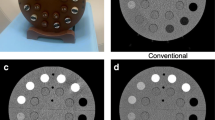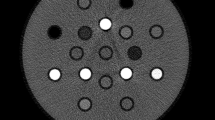Abstract
The relative electron density (RED) parameter is ubiquitous throughout radiotherapy for clinical dosimetry and treatment planning purposes as it provides a more accurate description of the relevant radiological properties over mass density alone. RED is in practice determined indirectly from calibrated CT Hounsfield Units (HU). While CT images provide useful 3D information, the spectral differences between CT and clinical LINAC beams may impact the validity of the CT-ED calibration, especially in the context of novel tissue-mimicking materials where deviations from biologically typical atomic number to atomic weight ratios 〈Z/A〉 occur and/or high-Z materials are present. A theoretical basis for determining material properties directly in a clinical beam spectrum via an electron-density equivalent pathlength (eEPL) method has been previously established. An experimental implementation of this approach is introduced whereby material-specific measured percentage depth dose curves (PDDs) are regressed to a PDD measured in a reference material (water), providing an inference of 〈Z/A〉, which when combined with the physical density provides a determination of RED. This method is validated over a range of tissue-mimicking materials and compared against the standard CT output, as well as compositional information obtained from the manufacturer's specifications. The measured PDD regression method shows consistent results against both manufacturer-provided and CT-derived values between 0.9 and 1.15 RED. Outside of this soft-tissue range a trend was observed whereby the 〈Z/A〉 determined becomes unrealistic indicating the method is no longer reporting RED alone and the assumptions around the eEPL model are constrained. Within the soft-tissue RED range of validity, the regression method provides a practical and robust characterisation for unknown materials in the clinical setting and may be used to improve on the CT derived RED where high Z material components are suspected.





Similar content being viewed by others
References
McGarry CK et al (2020) Tissue mimicking materials for imaging and therapy phantoms: a review. Phys Med Biol. https://doi.org/10.1088/1361-6560/abbd17
Andreo P, Burns D, Smyth V (2001) Absorbed dose determination in external beam radiotherapy: an international code of practice for dosimetry based on standards of absorbed dose to water IAEA. Technical Report Series No. 398. International Atomic Energy Agency, Vienna. https://www.iaea.org/publications/5954/absorbed-dose-determination-in-external-beam-radiotherapy
Kostiukhina N et al (2017) Advanced Radiation DOSimetry phantom (ARDOS): a versatile breathing phantom for 4D radiation therapy and medical imaging. Phys Med Biol 62(20):8136–8153. https://doi.org/10.1088/1361-6560/aa86ea
Niebuhr NI et al (2016) Technical Note: Radiological properties of tissue surrogates used in a multimodality deformable pelvic phantom for MR-guided radiotherapy: tissue surrogates for a multimodality phantom. Med Phys 43(2):908–916. https://doi.org/10.1118/1.4939874
International Commission on Radiation Units and Measurements (ed) (1989) Tissue substitutes in radiation dosimetry and measurement (ICRU 44). International Commission on Radiation Units and Measurements, Bethesda
Yemby Huamani T, Arnold Mullisaca P, Giancarlo Apaza V, Chen F, José Vega R (2019) Construction and characterization of materials equivalent to the tissues and organs of the human body for radiotherapy. Radiat Phys Chem 159:70–75. https://doi.org/10.1016/j.radphyschem.2019.01.013
Steinmann A et al (2018) Developing and characterizing MR/CT-visible materials used in QA phantoms for MRgRT systems. Med Phys 45(2):773–782. https://doi.org/10.1002/mp.12700
Schneider U, Pedroni E, Lomax A (1996) The calibration of CT Hounsfield units for radiotherapy treatment planning. Phys Med Biol 41(1):111–124. https://doi.org/10.1088/0031-9155/41/1/009
Burleson S, Baker J, Hsia AT, Xu Z (2015) Use of 3D printers to create a patient-specific 3D bolus for external beam therapy. J Appl Clin Med Phys 16(3):166–178. https://doi.org/10.1120/jacmp.v16i3.5247
Craft DF, Kry SF, Balter P, Salehpour M, Woodward W, Howell RM (2018) Material matters: analysis of density uncertainty in 3D printing and its consequences for radiation oncology. Med Phys 45(4):1614–1621. https://doi.org/10.1002/mp.12839
Dancewicz OL, Sylvander SR, Markwell TS, Crowe SB, Trapp JV (2017) Radiological properties of 3D printed materials in kilovoltage and megavoltage photon beams. Phys Med 38:111–118. https://doi.org/10.1016/j.ejmp.2017.05.051
Gallas RR, Hünemohr N, Runz A, Niebuhr NI, Jäkel O, Greilich S (2015) An anthropomorphic multimodality (CT/MRI) head phantom prototype for end-to-end tests in ion radiotherapy. Z Med Phys 25(4):391–399. https://doi.org/10.1016/j.zemedi.2015.05.003
Madamesila J, McGeachy P, Villarreal Barajas JE, Khan R (2016) Characterizing 3D printing in the fabrication of variable density phantoms for quality assurance of radiotherapy. Phys Med 32(1):242–247. https://doi.org/10.1016/j.ejmp.2015.09.013
Seco J, Evans PM (2006) Assessing the effect of electron density in photon dose calculations: effect of electron density in photon dose calculations. Med Phys 33(2):540–552. https://doi.org/10.1118/1.2161407
O’Connor JE (1957) The variation of scattered X-rays with density in an irradiated body. Phys Med Biol 1(4):352–369. https://doi.org/10.1088/0031-9155/1/4/305
Tino R, Leary M, Yeo A, Kyriakou E, Kron T, Brandt M (2020) Additive manufacturing in radiation oncology: a review of clinical practice, emerging trends and research opportunities. Int J Extreme Manuf 2(1):012003–04. https://doi.org/10.1088/2631-7990/ab70af
White DR (1978) Tissue substitutes in experimental radiation physics. Med Phys 5(6):467–479. https://doi.org/10.1118/1.594456
Moutrie V, Kairn T, Rosenfeld A, Charles PH (2015) Use of a megavoltage electronic portal imaging device to identify prosthetic materials. Australas Phys Eng Sci Med 38(1):93–100. https://doi.org/10.1007/s13246-015-0327-8
Karl A (2016) The production of custom bolus using 3D printers for applications in radiation therapy. Thesis, University of Canterbury. https://doi.org/10.26021/8811
Bibb R, Thompson D, Winder J (2011) Computed tomography characterisation of additive manufacturing materials. Med Eng Phys 33(5):590–596. https://doi.org/10.1016/j.medengphy.2010.12.015
Gammex (2006), Tissue Characterization Phantom Model 467 User’s Guide [manual]. Middleton, WI U.S.A: Gammex
Kemmer G, Keller S (2010) Nonlinear least-squares data fitting in Excel spreadsheets. Nat Protoc 5(2):267–281. https://doi.org/10.1038/nprot.2009.182
Low DA, Harms WB, Mutic S, Purdy JA (1998) A technique for the quantitative evaluation of dose distributions. Med Phys 25(5):656–661. https://doi.org/10.1118/1.598248
Diamantopoulos S, Platoni K, Patatoukas G, Karaiskos P, Kouloulias V, Efstathopoulos E (2019) Treatment plan verification: a review on the comparison of dose distributions. Physica Med 67:107–115. https://doi.org/10.1016/j.ejmp.2019.10.029
Micula G, Micula S (1999) Handbook of splines. Springer, Dordrecht. https://doi.org/10.1007/978-94-011-5338-6
Burleson S, Baker J, Hsia AT, Xu Z (2015) Use of 3D printers to create a patient-specific 3D bolus for external beam therapy. J Appl Clin Med Phys 16(3):Art. no. 3. https://doi.org/10.1120/jacmp.v16i3.5247
Funding
The authors declare that no funds, grants, or other support were received during the preparation of this manuscript.
Author information
Authors and Affiliations
Contributions
All authors contributed to the study conception and design. Material preparation, data collection and analysis were performed by ASK, JGS and GBW. The first draft of the manuscript was written by ASK and JGS. All authors commented on previous versions of the manuscript and read and approved the final manuscript.
Corresponding author
Ethics declarations
Conflict of interest
The authors have no relevant financial or non-financial interests to disclose.
Ethical approval
This article does not contain any studies with human participants or animals.
Additional information
Publisher's Note
Springer Nature remains neutral with regard to jurisdictional claims in published maps and institutional affiliations.
Rights and permissions
About this article
Cite this article
Karl, A.S., Steel, J.G. & Warr, G.B. Regression fitting megavoltage depth dose curves to determine material relative electron density in radiotherapy. Phys Eng Sci Med 46, 1387–1397 (2023). https://doi.org/10.1007/s13246-023-01306-8
Received:
Accepted:
Published:
Issue Date:
DOI: https://doi.org/10.1007/s13246-023-01306-8




